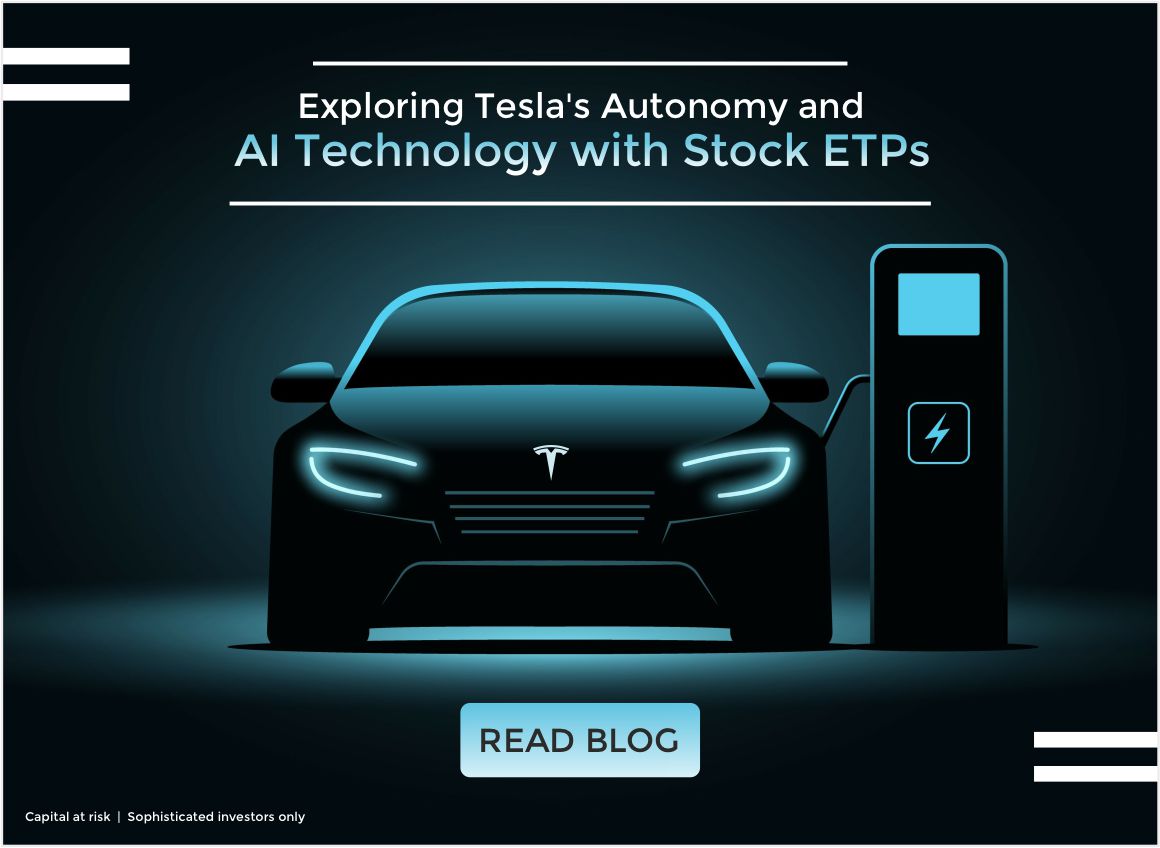Tesla's Autonomy & AI Tech with Stock ETPs
Posted:
The development of autonomous driving is being fueled by Tesla's Artificial Intelligence (AI) and autonomy technologies. Tesla intends to revolutionise transportation by enabling vehicles to drive without human intervention with its Autopilot systemand ongoing development of Full Self-Driving (FSD) services. While FSD aims for complete autonomy, the Autopilot system uses a combination of sensors, cameras, and AI algorithms to assist with driving responsibilities. The data gathered from the car's sensors is processed by Tesla's AI technology, which enables the car to perceive its surroundings and make judgements based on actual driving scenarios.
The potential impact of Tesla's Autonomy and AI Technology is significant, as it can enhance road safety, increase transportation efficiency, and promote the adoption of electric vehicles. With an array of investment alternatives available to obtain exposure to Tesla's developments in autonomy and AI technologies, investors are also paying attention to this technology. However, there are also risks and challenges associated with investing in this industry, such as market instability, regulatory barriers, and rivalry from other businesses. Despite these difficulties, autonomous vehicles might be a common sight on our roads in the future with the help of Tesla's AI and autonomous technology.
Understanding Tesla's Autopilot System
Tesla's Autopilot system is an advanced driver-assistance system (ADAS) developed by the company to enable semi-autonomous driving capabilities in their vehicles. It combines a suite of sensors, including cameras, radar, and ultrasonic sensors, with AI algorithms to assist drivers in various aspects of driving. The Autopilot system can control steering, acceleration, and braking, providing a hands-on, yet automated driving experience.
The Autopilot system utilizes AI technology to process the data captured by its sensors, allowing it to interpret the surrounding environment and make real-time decisions. The AI algorithms continuously learn and improve through machine learning, analyzing vast amounts of driving data from Tesla vehicles around the world. However, it is important to note that Tesla's Autopilot is not a fully autonomous driving system. Drivers are required to remain attentive and be ready to take control of the vehicle when necessary, as the system still relies on human oversight.
Tesla's Autopilot system has been praised for its advanced features, such as adaptive cruise control, lane-centering, and automatic lane changes. It provides convenience, enhances safety, and contributes to Tesla's mission of transitioning to sustainable transportation. The Autopilot system continues to evolve with regular software updates, introducing new functionalities and improving its performance.
Tesla's Full Self-Driving (FSD) Capability
Tesla's Full Self-Driving (FSD) capability represents the company's ambitious goal of achieving complete autonomy in its vehicles. While Tesla's Autopilot system provides advanced driver-assistance features, FSD aims to enable fully autonomous driving, where the vehicle can operate without any human intervention. The FSD capability utilizes Tesla's Autopilot hardware and software, along with additional enhancements, to achieve this level of autonomy.
The company's FSD capability relies on a combination of sensors, including cameras, radar, and ultrasonic sensors, along with AI algorithms to perceive and understand the surrounding environment. The AI algorithms analyze the sensor data in real time, making complex decisions to navigate the vehicle safely and efficiently. Tesla is continuously improving and refining its FSD capability through software updates, leveraging the collective driving data from their fleet of vehicles to enhance its performance and address various driving scenarios.
It's important to note that while Tesla's FSD capability is an impressive achievement, it is still in development and regulatory approval is required before it can be fully deployed. Tesla emphasizes the need for driver vigilance and compliance with local regulations, as the technology is not yet capable of operating without human oversight in all situations. Nonetheless, Tesla's FSD capability represents a significant step towards a future where vehicles can navigate autonomously, offering increased safety, convenience, and efficiency on the roads.
The Potential of Tesla's Autonomy and AI Technology
The potential of Tesla's Autonomy and AI technology is vast and holds the promise of transforming transportation and various industries. Here are three key areas where Tesla's technology has significant potential:
- Advancement in Autonomous Driving: Tesla's Autonomy and AI technology aims to achieve full self-driving capability, where vehicles can operate without human intervention. This has the potential to revolutionize transportation, making it safer, more efficient, and more convenient. Fully autonomous vehicles can significantly reduce accidents caused by human error and enable smoother traffic flow. Moreover, the integration of AI algorithms allows Tesla vehicles to continuously learn and improve their driving capabilities, enhancing their performance over time.
- Integration with Electric Vehicles: Tesla's Autonomy and AI technology is closely tied to their electric vehicle offerings. The combination of autonomous driving and electric propulsion has the potential to accelerate the adoption of sustainable transportation. By reducing reliance on fossil fuels and improving the efficiency of electric vehicles, Tesla's technology can contribute to combating climate change, improving air quality, and creating a more sustainable future.
- Expansion into Mobility Services and Shared Economy: Tesla's Autonomy and AI technology opens up opportunities in the realm of mobility services and the shared economy. With autonomous driving capabilities, Tesla vehicles can be deployed in ride-sharing services and autonomous vehicle fleets for on-demand transportation. This can lead to increased efficiency in vehicle utilization, reduced traffic congestion, and decreased need for individual car ownership. By enabling the growth of the shared economy, Tesla's technology can reshape the way people access and utilize transportation services.
While the potential of Tesla's Autonomy and AI technology is significant, it is important to address challenges such as regulatory frameworks, safety concerns, and public acceptance.
Evaluating the Performance of Autonomy and AI Technology ETPs
When evaluating the performance of Autonomy and AI Technology ETPs, consider the following factors:
- Historical Performance: Analyze the historical performance of the ETP over different timeframes, such as one year, three years, or since inception. Assess the ETP's returns compared to the benchmark or index it tracks. Look for consistent positive performance, taking into account market fluctuations and volatility in the autonomy and AI technology sectors.
- Expense Ratio and Fees: Consider the expense ratio and fees associated with the ETP. Lower expense ratios generally translate to higher returns for investors. Compare the expense ratio of the ETP with other similar products in the market to ensure it is competitive and reasonable.
- Assets Under Management (AUM) : Look at the AUM of the ETP, as it can provide an indication of investor confidence and market demand. Higher AUM may suggest that the ETP is well-established and has attracted significant investor interest. However, it's important to note that AUM alone should not be the sole criterion for evaluating an ETP's performance.
- Tracking Error : Tracking error is an important aspect to consider when evaluating ETPs. It measures the extent to which the ETP deviates from the performance of its underlying benchmark or index. A low tracking error indicates that the ETP closely mirrors the benchmark, providing investors with more accurate replication of the desired exposure. In the context of Autonomy and AI Technology ETPs, having very limited tracking errors, such as those offered by GraniteShares , can be advantageous as it helps ensure that investors can effectively capture the performance of the autonomy and AI technology sector.
Investment Opportunities with 3x Leverage Tesla Stock ETPs
Investment opportunities with 3x leverage Tesla Stock ETPs may be attractive for traders seeking to capitalize on short-term market movements and generate amplified returns. Leveraged ETPs aim to provide 3 times the daily return (or inverse return) of the underlying index, allowing investors to potentially magnify their gains in a short period. However, it's important to note that Leveraged ETPs come with a higher level of risk.
One potential benefit of 3x leverage Stock ETPs is their potential for quick profits in volatile market conditions. If an investor correctly predicts short-term price movements and has a well-timed entry and exit strategy, the leverage factor can amplify their returns. This can be appealing to active traders who closely monitor market trends and are adept at technical analysis.
However, it's important to consider the risks associated with 3x leverage ETPs. The amplified returns work in both directions, meaning that losses can also be magnified.
Given the higher risk profile, 3x leverage Stock ETPs are generally more suitable for experienced and sophisticated who are comfortable with volatility and have a deep understanding of the underlying market. It's crucial to conduct thorough research, stay updated on market trends, and have a disciplined approach to risk management when investing in these leveraged ETPs.
Risks and Challenges in Investing in Tesla and Autonomy ETPs
When considering investments in Tesla and Autonomy ETPs (Exchange-Traded Products), it is essential to be aware of the risks and challenges associated with such investments. Here are some key factors to consider:
- Volatility and Market Risk: Tesla and Autonomy ETPs can be subject to significant price volatility due to various factors, including market sentiment, technological developments, regulatory changes, and competition. Autonomy technology is still evolving, and the market for autonomous cars and other vehicles is highly dynamic, which can result in fluctuations in the value of ETPs.
- Regulatory and Legal Challenges: The development and deployment of autonomous driving technology are subject to regulatory frameworks and legal requirements. Changes in regulations or failure to meet regulatory standards could impact the viability and growth of the autonomy industry, affecting the performance of related ETPs. Additionally, legal challenges and liability concerns surrounding autonomous vehicles could pose risks for both Tesla and the autonomy sector as a whole.
- Technological Uncertainty: Autonomous driving technology is complex and requires continuous innovation and improvement. There are uncertainties regarding the timeline for achieving full autonomy, technological breakthroughs, and the effectiveness of AI algorithms. Delays or setbacks in the development of autonomy technology could impact the performance of Tesla and Autonomy ETPs.
- Competitive Landscape: The autonomy and electric vehicle sectors are highly competitive, with established automakers, technology companies, and startups vying for market share. Tesla faces competition from both traditional automotive manufacturers and tech giants investing in autonomy. The emergence of new entrants and disruptive technologies could pose challenges to Tesla's market position and impact the performance of Autonomy ETPs.
- Company-Specific Risks: Investing in Tesla ETPs exposes investors to company-specific risks, including production challenges, supply chain issues, financial performance, and leadership changes. Tesla's stock price can be influenced by factors unrelated to autonomous technology, such as market sentiment, investor perception, and macroeconomic conditions.
- Concentration Risk: Autonomy ETPs focused solely on Tesla may have a high concentration of risk. A significant portion of the ETP's performance may depend on Tesla's success in the autonomy and electric vehicle sectors. This concentration may increase the impact of company-specific events or fluctuations in Tesla's stock price on the ETP's performance.
It is important to carefully assess these risks and conduct thorough research before investing in Tesla and Autonomy ETPs. Diversification across different sectors and asset classes can help mitigate some of the specific risks associated with individual stocks or sectors.
Conclusion and Future Outlook
In conclusion, Tesla's Autonomy and AI technology has immense potential to reshape transportation, enhance road safety, and drive innovation across various industries. The Autopilot system and ongoing development of Full Self-Driving (FSD) capability represent significant advancements in autonomous driving, offering features that improve convenience, efficiency, and user experience. Tesla's AI algorithms and data-driven approach contribute to continuous learning and improvement, pushing the boundaries of what autonomous vehicles can achieve. Tesla's Autonomy and AI Technology have the potential to revolutionize the automotive industry by driving cars with advanced autonomous capabilities, and under the leadership of Elon Musk, it offers long-term prospects for investors considering Stock ETPs.
However, it's important to acknowledge the challenges and considerations associated with Tesla's Autonomy and AI technology. Regulatory hurdles, safety concerns, and the need for human oversight are critical factors that must be addressed for widespread adoption. Moreover, competition in the autonomous driving space is intensifying, with other automotive and technology companies also investing in this transformative technology.
Leverage Tesla ETPs by GraniteShares
| Product name | Ticker | ||
|---|---|---|---|
| USD | EUR | GBX | |
| 3STS | 3STE | 3STP | |
| 3LTS | 3LTE | 3LTP | |
DISCLAIMER
Please note that GraniteShares short and leveraged Exchange Traded Products are for sophisticated investors.
This is a disclaimer stating that all trading and investing come with risks. Always do your research and do not invest more than you can afford to spend.
GraniteShares accepts no responsibility for any loss or damage resulting directly or indirectly from the use of this blog or its contents.
This blog does not constitute an offer to buy or sell or a solicitation of an offer to buy securities in any company. Nothing contained herein constitutes investment, legal, tax or other advice nor is it to be relied upon in making an investment or other decision. No recommendation is made positive or otherwise, regarding individual securities or investments mentioned herein. Any summary list of risk factors does not purport to be a complete enumeration or explanation of the risks involved in a particular investment. Prospective clients must consult with their own legal, tax and financial advisers before deciding to invest. This email contains the opinions of the author, and such opinions are subject to change without notice. The source of data is GraniteShares unless otherwise stated. No guarantee is made to the accuracy of the information provided which has been obtained from sources believed to be reliable. This email and the information contained herein are intended only for the use of persons (or entities they represent) to whom it has been provided. Past performance is not a reliable indicator of future results. The value of an investment may go down as well as up and can result in losses, up to and including a total loss of the amount initially invested. Investments may involve numerous risks including, among others, company risks, general market risks, credit risks, foreign exchange risks, interest rate risks, geopolitical risks, and liquidity risks.


